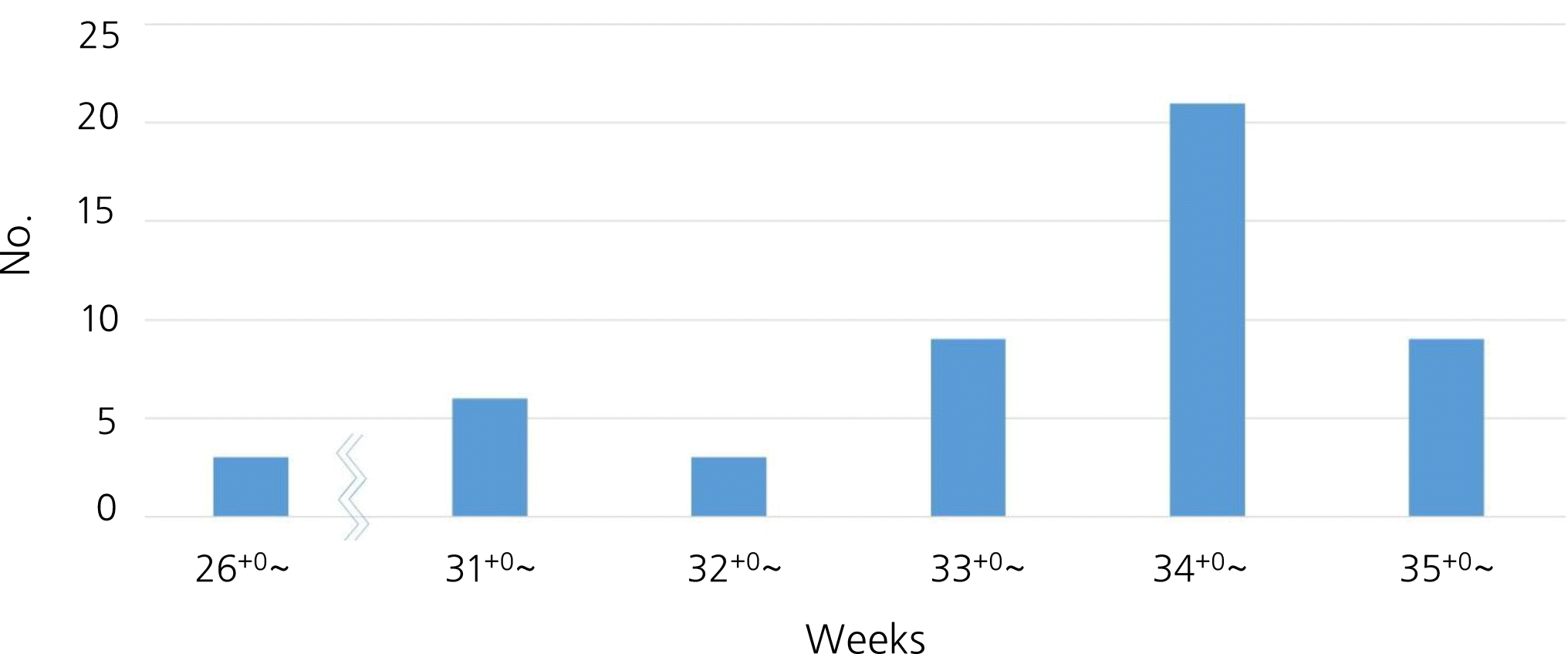1). Korean Statistical Information Service. Annual report on live births and deaths statistics. [accessed on 1 July 2017]. Available at. http://kosis.kr/ups/ups_01List.jsp?pubcode=CC.
2). Centers for Disease Control and Prevention. QuickStats: Mean Gestational Age, by Plurality. [accessed on 1 July 2017]. Available at. https://www.cdc.gov/mmwr/preview/mmwrhtml/mm5709a9.htm.
3). Stahlman M., Hedvall G., Dolanski E., Faxelius G., Burko H., Kirk V. A six-year follow-up of clinical hyaline membrane disease. Pediatr Clin North Am. 1973. 20:433–46.

4). Jobe AH., Bancalari E. Bronchopulmonary dysplasia. Am J Respir Crit Care Med. 2001. 163:1723–9.

5). Papile LA., Burstein J., Burstein R., Koffler H. Incidence and evolution of subependymal and intraventricular hemorrhage: a study of infants with birth weights less than 1,500 gm. J Pediatr. 1978. 92:529–34.

6). Aabera T., Ben-Sira I., Charled S., Clarkson J., Cohen BZ., Flynn J, et al. An international classification of retinopathy of prematurity: II. The classification of retinal detachment. Arch Ophthalmol. 1987. 105:906–12.
7). Cassell KA., O'connell CM., Baskett TF. The origins and outcomes of triplet and quadruplet pregnancies in Nova Scotia: 1980 to 2001. Am J Perinatol. 2004. 21:439–45.

8). Centers for Disease Control and Prevention. Final Data for 2015. National Vital Statistics Reports. [accessed on 1 July 2017]. Available at. http://www.cdc.gov/nchs/births.htm.
9). Ballabh P., Kumari J., AlKouatly HB., Yih M., Arevalo R., Rosenwaks Z, et al. Neonatal outcome of triplet versus twin and singleton pregnancies: a matched case control study. Eur J Obstet Gynecol Reprod Biol. 2003. 107:28–36.

10). Chae SJ., Yoo WJ., Kang KH., Kim BJ., Lee SE., Sohn YK, et al. Perinatal outcomes of triplet pregnancies. Korean J Obstet Gynecol. 2006. 49:1051–9.
11). Orlebeke JF., Boomsma DI., Eriksson AW. Epidemiological and birth weight characteristics of triplets: a study from the Dutch twin register. Eur J Obstet Gynecol Reprod Biol. 1993. 50:87–93.

12). Ho ML., Chen JY., Ling UP., Chen JH., Huang CM., Chang CC, et al. Changing epidemiology of triplet pregnancy: etiology and outcome over twelve years. Am J Perinatol. 1996. 13:269–75.

13). Loucopoulos A., Jewelewicz R. Management of multifetal pregnancies: sixteen years' experience at the Sloane Hospital for Women. Am J Obstet Gynecol. 1982. 143:902–5.

14). Alran S., Sibony O., Luton D., Touitou S., Fourchotte V., Féraud O, et al. Maternal and neonatal outcome of 93 consecutive triplet pregnancies with 71% vaginal delivery. Acta Obstet Gynecol Scand. 2004. 83:554–9.

15). Güngör ES., Tapısız ÖL., Aytan H., Danışman N., Kalyoncu Ş., Mollamahmutoğlu L. Maternal and neonatal outcome of triplet versus twin and singleton pregnancies. Gazi Med J. 2006. 17:45–48.
16). Choi CI., Chung IB., Oh GY., Choi KD., Choi HI., Han HD, et al. Maternal and perinatal outcomes in triplet versus twin pregnancies with the result of Assisted Reproductive Technology. Korean J Obstet Gynecol. 1999. 42:2013–8.




 PDF
PDF ePub
ePub Citation
Citation Print
Print




 XML Download
XML Download